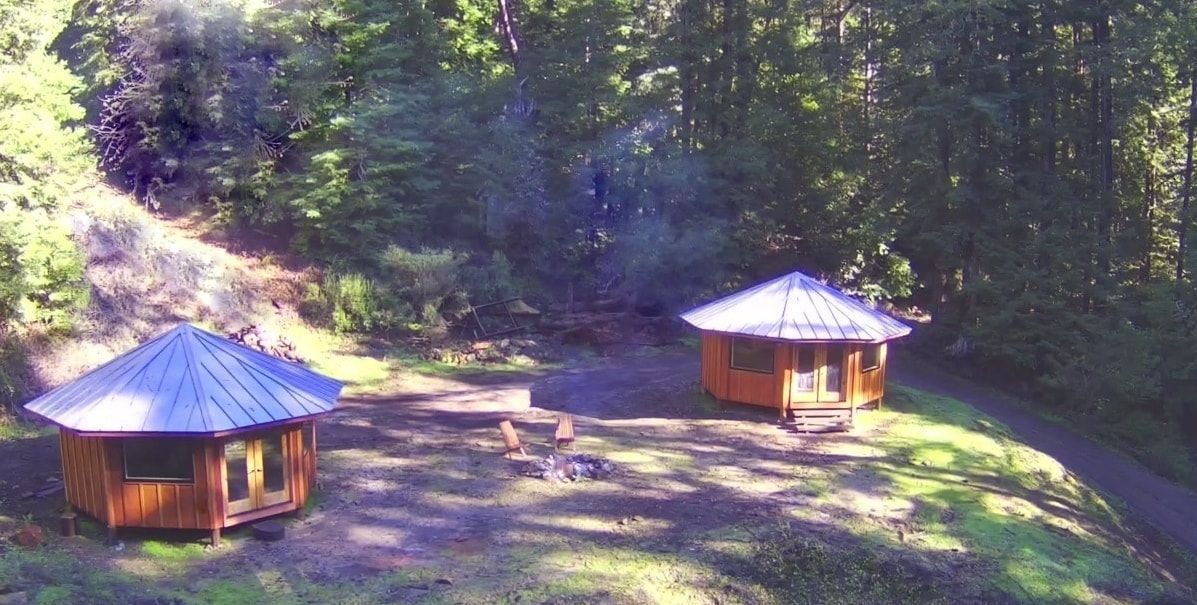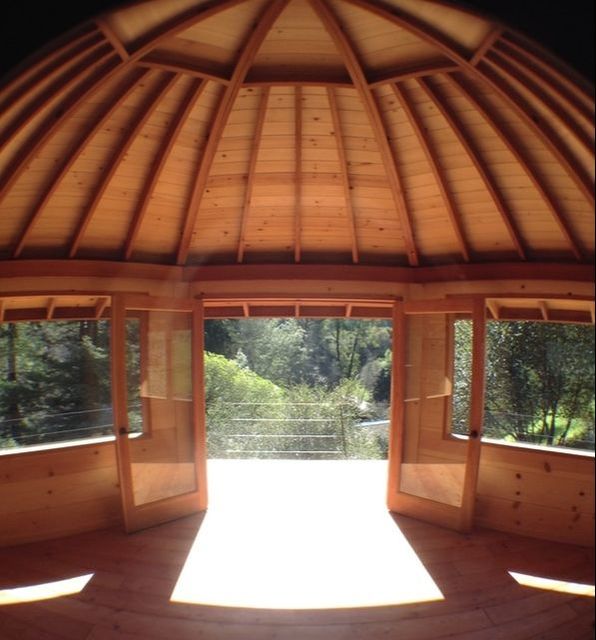Pacific Coast Cabins are rugged luxury cabins, handcrafted with environmentally friendly materials, custom built, flat-packed and delivered to your location.
These round house kits easily assemble into efficiency studios, rural guesthouses, beach huts, art studios, and home offices, and are ideal for eco-resort lodging, luxury camping and affordable housing.
These round house kits easily assemble into efficiency studios, rural guesthouses, beach huts, art studios, and home offices, and are ideal for eco-resort lodging, luxury camping and affordable housing.
Round in shape, celebrating the warm glow of wood and natural lighting,
our cabin design was inspired by a love of wild and beautiful places.
WHY ROUND?

Humanity has enjoyed the benefits of round shelter for well over 10,000 years. At one time, round symmetrical shelter enhanced survival by providing the strongest, most stable structure. Today, a round home provides a strong sense of comfort and well being by reflecting the natural environment that shaped us.
A round house was also symbolic at one time, in that it once served as an "imago mundi" or model of the cosmos. Indigenous peoples who viewed the world as round, naturally occurring and interconnected, rather than linear, mechanical and fragmented, modeled their shelter to symbolically reflect their experience. All around the planet we find that round shelter has historically been the very first and most universal type of living space constructed by humans. Structures such as the European roundhouse, African rondawel, Spanish palloza, Navaho hogan, Lakota tipi, Samoan beach fale, Fijian bure, North American wigwam, Anasazi kiva, Mongolian yurt, the round houses of Jericho - the first known town, the trulli of Southern Italy, the Inuit igloo and many others, all provide round living environments.
A round house was also symbolic at one time, in that it once served as an "imago mundi" or model of the cosmos. Indigenous peoples who viewed the world as round, naturally occurring and interconnected, rather than linear, mechanical and fragmented, modeled their shelter to symbolically reflect their experience. All around the planet we find that round shelter has historically been the very first and most universal type of living space constructed by humans. Structures such as the European roundhouse, African rondawel, Spanish palloza, Navaho hogan, Lakota tipi, Samoan beach fale, Fijian bure, North American wigwam, Anasazi kiva, Mongolian yurt, the round houses of Jericho - the first known town, the trulli of Southern Italy, the Inuit igloo and many others, all provide round living environments.

A round structure reflects for us the shape of the natural world.
Biomimicry, the modern practice of imitating nature in design, encourages us to create structures that resemble the natural world, and to design homes not just for shelter, but for well-being. Research shows that built environments affect our emotional and cognitive health and that good architecture has the ability to reduce stress. Rounded features are found to be more attractive and relaxing than rectangular features. A functional MRI study conducted by the National Academy of Sciences showed that "participants were more likely to judge spaces as beautiful if they were curvilinear rather than rectilinear."
"We shape our buildings; thereafter they shape us."
- W. Churchill
Psychosocial Value of Space | Whole Building Design Guide
Benefits of Round Houses
The benefits of round houses also include greater energy efficiency, better air circulation, better aerodynamics in high wind, less material cost to build, better acoustics, greater strength, durability and flexibility, and safer during earthquakes than rectangular structures.
WHY WOOD?
Wood is the most useful sustainable building material available. It is beautiful, natural, durable, self-renewing and carbon neutral. It is a natural insulator, it is cost effective, it is strong and it is flexible. https://econation.one/wood/
Wood may be our most environmentally friendly building material when sustainably harvested.
Wood also presents to us the face of nature. Our preference for natural materials could be a direct result of our biology and natural evolution. Enjoying the warmth of wood may be an example of our natural affection for living things, or biophilia.
Biophilic design is used in architecture to increase human well-being through connection to nature. Natural elements such as sunlight, plants, water and wood increase our overall positive experience, reducing stress and boosting productivity and creativity.
Research from the U.S., Canada, Austria, and other countries found that humans automatically relax when they are surrounded by elements from the natural world. A University of British Columbia study found that the visual presence of wood surfaces in a room lowers stress levels through biophilia. http://nordic.ca/data/files/publication/Wood_Human_Health_final-single.pdf
The visual use of wood in architectural design clearly contributes to our overall health and well-being.
Biomimicry, the modern practice of imitating nature in design, encourages us to create structures that resemble the natural world, and to design homes not just for shelter, but for well-being. Research shows that built environments affect our emotional and cognitive health and that good architecture has the ability to reduce stress. Rounded features are found to be more attractive and relaxing than rectangular features. A functional MRI study conducted by the National Academy of Sciences showed that "participants were more likely to judge spaces as beautiful if they were curvilinear rather than rectilinear."
"We shape our buildings; thereafter they shape us."
- W. Churchill
Psychosocial Value of Space | Whole Building Design Guide
Benefits of Round Houses
The benefits of round houses also include greater energy efficiency, better air circulation, better aerodynamics in high wind, less material cost to build, better acoustics, greater strength, durability and flexibility, and safer during earthquakes than rectangular structures.
WHY WOOD?
Wood is the most useful sustainable building material available. It is beautiful, natural, durable, self-renewing and carbon neutral. It is a natural insulator, it is cost effective, it is strong and it is flexible. https://econation.one/wood/
Wood may be our most environmentally friendly building material when sustainably harvested.
Wood also presents to us the face of nature. Our preference for natural materials could be a direct result of our biology and natural evolution. Enjoying the warmth of wood may be an example of our natural affection for living things, or biophilia.
Biophilic design is used in architecture to increase human well-being through connection to nature. Natural elements such as sunlight, plants, water and wood increase our overall positive experience, reducing stress and boosting productivity and creativity.
Research from the U.S., Canada, Austria, and other countries found that humans automatically relax when they are surrounded by elements from the natural world. A University of British Columbia study found that the visual presence of wood surfaces in a room lowers stress levels through biophilia. http://nordic.ca/data/files/publication/Wood_Human_Health_final-single.pdf
The visual use of wood in architectural design clearly contributes to our overall health and well-being.
Surrounding ourselves with natural materials connects us to an authentic world.

Pacific Coast Cabins are built for those who appreciate the natural world.
Our cabin kits are free of the toxic building materials often used in standard residential construction. No plastic, paint, varnish, urea-formaldehyde, vinyl or composites are used in our original kit design. We use only sustainably harvested wood, steel fasteners, building paper, plywood and natural oil finishes.
These cabins rest lightly on the land, yet have an expected lifespan of over 70 years. Our light, low impact, engineered foundation options are gentle on the landscape. Our prefab building methods generate 50-75% less waste than conventional construction, and our round structures use 15-20% less materials than rectangular structures of the same size, allowing for more affordable construction.
We do everything we can to build high-quality, life-enhancing shelter without harming the natural environment.
Nature presents our best reference point.
Live outside the box.
"We have nothing but good things to say about Pacific Coast Cabins...a joy to work with from start to finish. The cabin feels custom and serene and exceeded our expectations. Thank you!" - C.A.
"Outstanding design and beautifully constructed. I would highly recommend this company" - W.R.
"The cabin is a joy to inhabit..... feels expansive, warm and light. It has been carefully crafted with an aesthetic attention to detail...... Plenty of enthusiasm, creativity and good vibes went into the construction and it was a pleasure to work with Pacific Coast Cabins." - G.K.
"It's wonderful!...super happy with it". - H.F.
Copyright ©2024 Pacific Door, Santa Cruz, CA. All Rights Reserved



